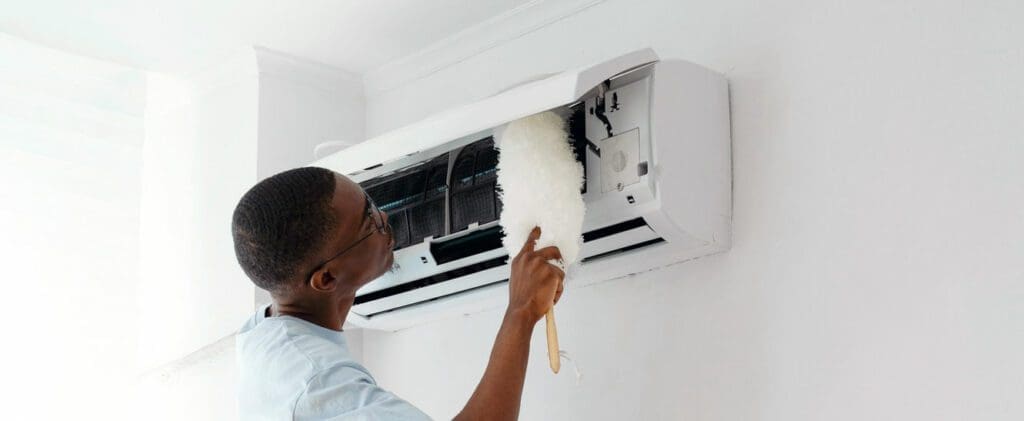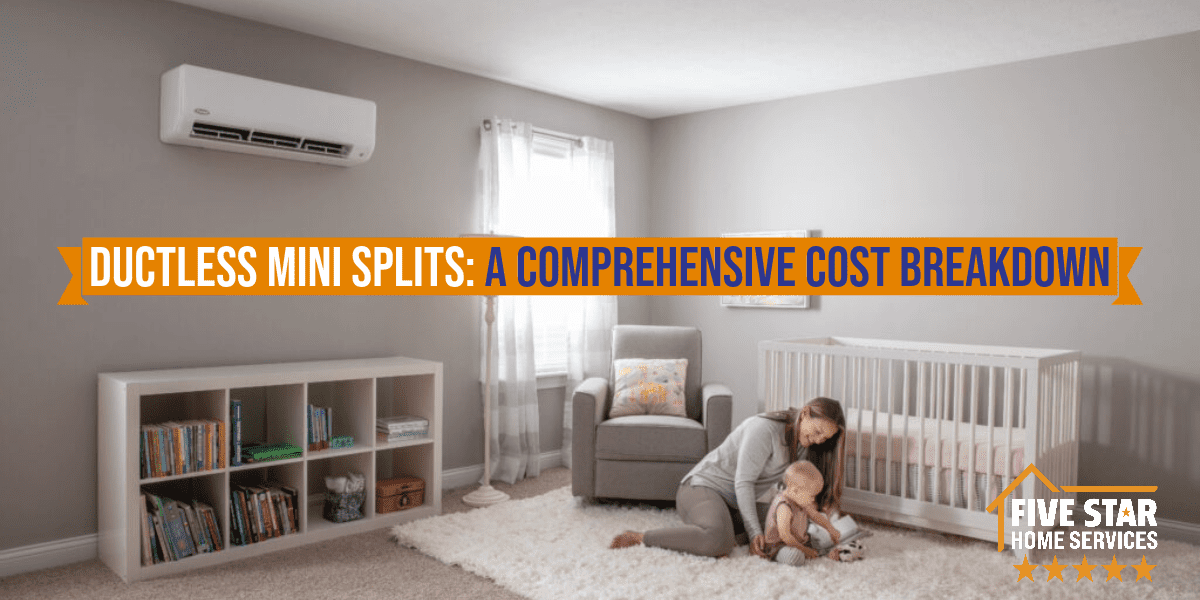What Is a Ductless Mini-Split?
A ductless mini-split system is a home comfort system that does not require air ducts to operate. Traditional air conditioners distribute air throughout the home from a single unit. A mini-split indoor unit services a single room or specific area, with each unit using a separate fan and evaporator coil.
A Comprehensive Cost Breakdown for Ductless Mini-Split Systems
Looking for a unique solution to your heating and cooling needs? If so, you should consider a ductless mini-split. These systems can be great solutions in certain settings. In the following, we will break down the costs and help you understand what contributes to this pricing and the overall costs.

If you’ve ever heard about ductless mini-splits and wondered about their efficiency, cost, or usefulness compared to traditional air conditioners or furnaces — you are not alone. There’s a lot to digest here, so your friends at Five Star Home Services plan to help you understand these amazing systems.
Ductless mini splits are great solutions for certain types of heating and cooling issues. They give homeowners a high degree of control over their home temperature while reducing comfort-associated costs.
We all love to save money! However, there are several important factors to consider when deciding if a mini-split is right for you. We have installed hundreds of mini-splits over the years, and we’ve spoken with thousands of homeowners who’ve considered one.
In the following, we’ve laid out the factors that go into the cost of a ductless mini-split and how each contributes to your home’s comfort. In the following, you’ll know how much a mini-split can cost, as well as whether or not it’s an option that is right for you and your home.
Types of Outdoor Mini-Split Units
Next, we’ll explore the different types of mini-splits. Whenever a homeowner thinks of a mini-split, they often think of a single wall unit. While this is the most common type, it is far from being the only type, as you will see.
On a side note, the biggest factor affecting mini-split costs is the number of “heads” that it has. A head is an individual indoor unit that is connected to the outdoor unit and provides heating or air conditioning to certain rooms or specific areas. Mini-splits can have up to five heads. The more heads a unit has, the more complicated it becomes to install, service, and maintain the system properly. Naturally, costs go up.
Because mini-splits normally go inside attics and basements, you might be wondering why you would need five heads. The answer is simple. A lot of homeowners won’t need these extra indoor units, provided they have the ductwork installed for a traditional HVAC system. Nevertheless, there are homes that lack proper ductwork, and installing it might be too costly. These homes generally don’t have convenient areas to install new ductwork. In these scenarios, their only option might be a ductless system. In larger homes, they might need multiple heads. It is still an extremely effective, efficient, and money-saving option. At Five Star Home Services, we offer the best prices on ductless mini split installation. Just see what other customers have to say!
Tonnage & BTUs
One important factor related to the number of indoor units is the “tonnage.” This is what is required to supply them with the proper power. BTU is short for British Thermal Unit. This is a measurement of heat, which is defined as the amount of heat required to raise the temperature of one pound of water by one degree Fahrenheit. Precise calculations taken by our HVAC technicians let you know the tonnage required to properly heat or cool your home. One example would be 36,000 BTU heat gain / 12,000 BTU per ton = 3-ton capacity.
With these calculations, if your mini-split is intended for a single room or small area, you’re probably okay with a 0.5-ton unit that has a single head. However, a larger house can run up to 5 tons of capacity.
This has implications for the HVAC equipment needed and installation practices to ensure proper heating and air conditioning throughout the ductless system. To give you a point of reference, a traditional heating or air conditioning system usually runs from 1.5 tons to 5 tons. In this way, mini-splits come with more options on the lower end as well. The result can be an HVAC system that’s more efficient and more catered to an individual room or part of your home. Your friends at Five Star Home Services are here to help you get the most out of your home comfort equipment, regardless of what you end up choosing.
The simplest way to determine your heating system’s AFUE rating would be to go to your furnace and look at the BTU input matched by the BTU output. This helps you determine what actual percentage your furnace is producing and how much heat it is using.
Type of Indoor Head
Not all indoor units are made the same. Mini-splits offer a few distinct varieties:
- Floor units run along the ground in a room.
- Wall units are mounted at or above eye level against walls.
- Ceiling cassettes are basically flush with the surface of your ceiling on a roof, with the air being pushed through a vent in the ceiling cassette.
The electrical work, carpentry, and other elements of the installation can differ significantly between these types. In general, ceiling cassettes are the most expensive. Although they are the least intrusive, they also usually require additional work to be installed properly.
Save on installation costs by considering condensate drainage when placing your indoor unit. If your unit can use gravity to drain condensate outdoors, no extra equipment is necessary. But if gravity isn’t an option, a condensate pump is essential. Unfortunately, condensate pumps have an additional upfront cost. There can also be ongoing maintenance costs as well. Knowing this, you should weigh all your options.
Distance From Outdoor to Indoor Units
In most mini-split installations, we provide 15 feet of line between the indoor and outdoor units. This line contains the electrical hook-ups as well as the drainage pipe for both indoor and outdoor units. If 15 feet isn’t long enough to travel between the two units and you need more length, the price can go up to meet your needs.
At Five Star Home Services, we provide a line cover as part of our standard installation. This cover does several important things:
- Allows the line to blend into the side of a home better
- Protects the line from wear and tear of the elements
- Paint for further modification to match your needs
A line cover is a good idea many installers don’t include it in their installations. If you’re worried about unsightly HVAC lines running along the side of your home, or the collective effect of the elements, this can be a great solution.
Does the Mini-Split Heat?
Sometimes homeowners purchase a mini-split to run during the hot summer months to cool a specific room that doesn’t have ductwork running to it (including attics, basements, etc.). Sometimes, however, homeowners want to use a room or area year-round — such as guest houses, finished basements, or garages that double as workrooms. In these cases, the mini-split needs to be able to both heat and cool.
Mini-splits that provide heat operate a lot like a heat pump; it can either heat or cool depending on the time of year and other factors. These units cost more than those that are only cools but also provides year-long comfort.
Control Options
Most mini-split heads have a standard remote control. Because they are variable-speed and they manage air conditioning or heating levels — they give you a lot of remote control over each area they service.
More and more modern systems are also coming with the option to synchronize your mini-split to a phone app. For example, many of the models we install here at Five Star Home Services come with specialized apps that provide detailed control over as many indoor units as you own. They have a lot of “smart” features such as setting alerts and automatic shutoffs. Nevertheless, everything is extremely user friendly and the app ownership can also be transferred if you sell your home.
One of the biggest benefit of these systems is that it provides “zone control” over different rooms, or zones. You can cool one room, heat another, and leave off all the others if you have a multi-head system.
Mini-Split Costs
Discover the cost of installing a ductless mini-split system with our comprehensive guide. Prices can vary depending on several factors, but anticipate paying between $5,000 and $8,000 per zone. If you have more than two zones, prices start at $11,000. For a complete house installation, expect to spend $20,000 or more. Overall, costs can range from $5,000 to $30,000 or even higher. Keep in mind that single-room mini-split systems tend to be on the lower end of the price spectrum. When comparing quotes, ensure that all labor fees and additional expenses are included for an accurate comparison.
At Five Star Home Services, all of our estimates include these charges — includes installation costs, which are often left out of cost listings displayed online. Installations can be very tricky. They can have complicated needs and require specialized equipment and tools as well as flammable and combustible materials. In the end, this can run you up to the thousands of dollars depending on the system.
When you get quotes, make sure you’re comparing “apples to apples.”
You should also keep a close eye on the qualifications of the installation company. The difference between a true professional installation and one that is mediocre at best results in years of usage on the lifespan of your system, in addition to the reduction in efficiency and comfort.
It is possible, nevertheless, to find cheaper installations. You could hire a local handyman “near me” or find a second-rate contractor or family business. However, you always run the risk of problems that could cost you more in the long run, especially when there isn’t 24/7 HVAC support, certified installation and certified service, and the proper training. We at Five Star Home Services ensure you get the efficiency you deserve from your system.
Another way of putting it: If it’s less expensive, there’s a reason for that. You get what you pay for in this business. Make sure you understand this and that you carefully weigh all of your options.
Lower range prices for mini-split installations represent single-head systems that need no more than 15 feet of line and minimal additional installation work. Upper range prices include multi-head systems with more complex installation and mechanical requirements. They often have a more powerful outdoor unit powering the various indoor units. We walk you through all this carefully when you choose Five Star Home Services!
The Benefits, And The Next Steps
Now that we’ve discussed all that and you are a little more familiar with the costs, we will now explore some of the additional reasons you might want to consider a ductless system. Those reasons include the following:
Environmentally Friendliness: Ductless mini splits are among the most environmentally friendly HVAC equipment on the market.
No Ductwork: For homes without existing ductwork, the cost to properly install ductwork can exceed that of a heating and cooling system. Mini splits make a great alternative.
Efficiency: Mini-splits often operate with a 33 SEER Rating! This is much higher than even high-efficiency central air conditioners.
Zone Control: Cost savings from zone control is usually immense. You can heat the play room in your basement while keeping the guest room in the attic cool; you can turn units on and off as you go about your day, or automate them with your phone so that you never have to worry about energy usage.
Even Heating & Air Conditioning: Modern HVAC systems sense hot or cold spots within a room and adjust accordingly to provide optimal, consistent comfort throughout a zone.
Looking for the best prices on ductless mini-split systems?
Look no further than Five Star Home Services! We have your back!
Schedule your in-home appointment today so we can discuss all of your options with one of our Comfort Specialists, get an exact quote for your home, and make the decision that best suits your budget and comfort needs.

